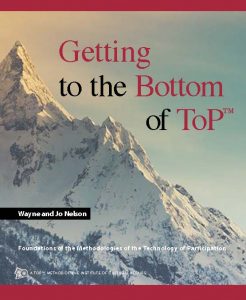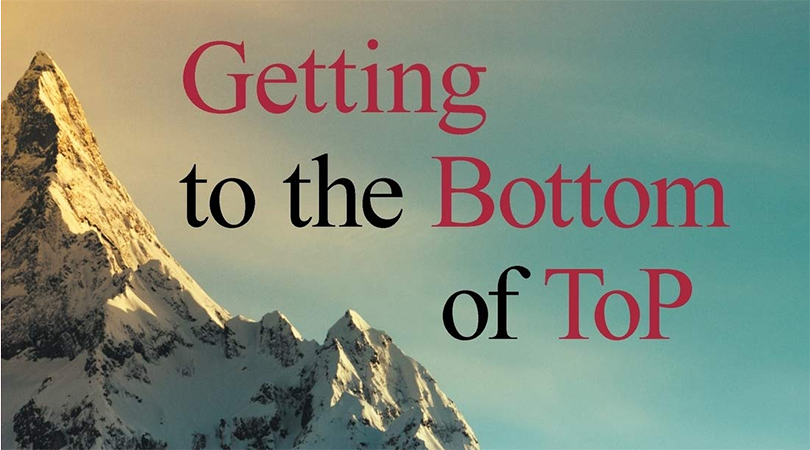Revealing Depth and Substance through ToP Methodology
Revealing Depth and Substance through ToP Methodology

One of the hallmarks of ICA’s Technology of Participation is that its use not only gets practical results, but evokes thoughtfulness, revealing the substantial insights that a group is capable of exploring and building upon. The key to creating group insight is the application of the methodology that underlies all of ToP methods. The four levels in the methodology take the group step by step from surface to depth thinking. In the Focused Conversation Method, the steps of the methodology are evident in the questions that are asked. In other ToP methods, the same underlying flow from surface to depth is followed but each uses different activities for each level.
The following description of the underlying methodology is drawn from Chapter 3 in Getting to the Bottom of ToP.
The Levels of ToP Methodology
The stages or steps used in ToP methodology have been called levels, because each step takes the conversation deeper into the topic and deeper into the relationship the group takes to it. Each level is a distinct mode of thinking dominated by a particular type of information processing. These levels form the core of ToP methodology. They have been applied in myriad ways. We use the same terminology to explain the steps in the Focused Conversation Method. We use the four stages in other applications as well. Often the first initials of the levels are condensed into an acronym, ORID, as a mnemonic for the four levels, but sometimes different terms are helpful in describing the specific steps of a particular method.
The objective level
We find the reality and meaning of life in this real, palpable, observable, sensory world. It is right here and now that we live.
We begin with “what is” and create a common foundation of reality for discussions and collaborative work. Each inquiry starts with a tangible beginning point, the “what is.” This might be the movie we just viewed or last month’s activity report. We might begin with a focus question, like “What are the elements we want to include in this new program?” This step enables all participants to bring their attention together on the most basic information necessary for the discussion. It also allows everyone to participate in the conversation based on the same information.
At this stage in the process the point is to observe and articulate the most basic information about the topic under consideration. We pay attention and perceive what is before us. If we are reflecting on a movie, for example, we look for the characters, the objects, the scenes and lines of dialogue in order to bring to consciousness what is actually present. If we’re discussing a discussion about a report, the questions enable the group to bring to their attention what is actually said. Beginning at this level grounds the discussion in reality.
The facilitator’s questions are simple, direct and non-threatening. They bring the group’s focus to a topic and seek descriptions of reality as indicatives rather than imperatives. They draw people out of their own observation and reflection and into a group focused on a common concern.
Brainstorming is one way to generate ideas in relation to a question. Alex Osborn popularized it in a 1953 book called Applied Imagination.[1] ToP methodology often uses brainstorming as the initial step in an inquiry. In ToP methodology, individual silent brainstorming usually precedes group brainstorming, to allow each individual to reach into their own mind for the information before group noise obscures it.
The objective level asks us to examine what is before us and “objectify” our perceptions. We become lucid about what is present to us and we create a foundation for further inquiry.
The reflective level
Along with making comparisons, we make associations and connections among ideas automatically. It’s natural and unavoidable. Feelings are triggered by our experiences and perceptions. We remember things. We see connections with other things. These associations and feelings are as substantial as the externally observable data, and must be considered seriously in making decisions. While they may seem more ephemeral than an observation or a well-honed idea, they play a major role in how we approach reality. It’s not hard to see that Husserl’s thoughts about comparing related phenomena led us to see that there is another area to examine. The breakthrough made by Kierkegaard, Brentano and Husserl was that subjective information must be included if we are to be inclusive in our inquiries.
Our images, memories and feelings reveal valuable information. They open us to the world of intuition, memory, emotion and imagination. Examining our experience makes us conscious, enriches our dialogue and makes it real. It helps us “experience our experience.” We are able to articulate the associations, memories and feelings so we are able to relate to the material at the objective level and move beyond it to a deeper, more personal exploration of the topic. Without conscious effort at this level, people can get stuck in reliving what happened and become unable to move beyond emotion. In conversations, this level takes the form of questions that explore this inner world.
ToP calls this the reflective level, because it asks us to step back, identify, acknowledge and reflect on our initial perceptions. We bring our associations, memories, feelings and intuitions about something to conscious awareness. They become real and have a life beyond the moment. Identifying and owning our initial responses enables our reflections to inform the relationship we chose to take to our given situation.
The interpretive level
Once we get this far in an inquiry, where do we go next? The phenomenologists say we’re looking for “patterns of meaning.” It seems quite natural to ask those questions next. Insight arises out of reflection on real experience. The objective and reflective levels prepare us to look deeper into the topic and move closer to answers to the larger question guiding our inquiry.
Meaning is created out of the mundane encounters in the midst of life. Meaning is something we all have to work at constantly, by thoughtfully reflecting on the actual life we have on our hands. We work through the layers of meaning, purpose, significance, implications, “story” and values to get to the core. We create intentional patterns and connections between elements, either by categorizing or gestalting the data. We consider alternatives and options open to us. A group can develop insight and understandings and they can move forward together. Obviously, each inquiry will be shaped by the specific question that gives it focus.
ToP calls this the interpretive level, because it is here that we analyze, gain understanding and determine what is significant. When we create genuinely shared understanding, we are more able to make insightful choices that are the will of the group.
The decisional level
Insight is a fine thing. Ideas move us forward. If processing insight about life is to be complete, grounded and genuinely meaningful, it must move from abstract insight to something more tangible, and it involves projecting that insight out into the future. Whether that insight is practical or transcendent, it must have an impact on our lived lives.
As we decide future implications for action, our reflection connects us to the world in ways that are real. We assume active responsibility for our situation. We make choices and commitments that shape our way of interacting with our situation. In groups, we make decisions and build consensus, so we can move forward together. In some cases, this means making decisions and choices. In others it means placing actions on a timeline or action agenda. Doing so gives concrete form to the resolution.
We call this the decisional level. It enables us to develop an appropriate conclusion to a given inquiry. When we make choices, we commit ourselves to a way forward. Well-designed process at the decisional level gives collaborative decision-making real power. In situations where the focus is functional thought such as solving a problem, the term decisional captures the intent of this step in the process. The term decisional is likely to survive as the common name for this activity within the framework of ToP facilitation, but other names illuminate what can happen at this level as well.
When the methodology is used in situations of substantial thought, the generation of transcendent insight, or the activity of consciously forming one’s stance toward life, this level has been called theological and symbolic. Based on Kierkegaard’s work, it has also been called the relational or existential level. Similarly, John Kloepfer has called this level maieutic.[2] Derived from the Greek for midwife, maieutic questions bring forth latent knowledge, depth understanding and transcendence. In the specific applications derived from this usage, people are provided with ways to take their insight and move beyond the material, physical plane of this world and connect themselves with transcendent reality.
The four stages of the content-less method of inquiry provide the foundation for all the specific ToP methods, and allow facilitators to create new methods and designs to meet new situations.
[1] Osborn, Alex. Applied Imagination. New York: Scribner, 1953
[2] Kloepfer, 1990.





